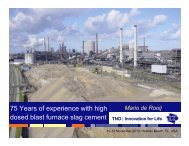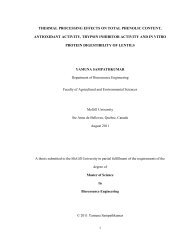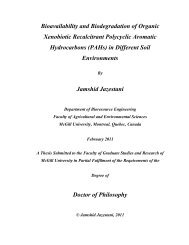Calcium Aluminate Cements Revisited - McGill University
Calcium Aluminate Cements Revisited - McGill University
Calcium Aluminate Cements Revisited - McGill University
Create successful ePaper yourself
Turn your PDF publications into a flip-book with our unique Google optimized e-Paper software.
Conclusions and Future Work<br />
Early‐age volume change<br />
• Vastly different behavior than portland<br />
cement<br />
• Highly temperature dependent<br />
Conversion Testing<br />
• Immediate high temperature curing not<br />
applicable due to microstructural changes<br />
• Curing at 38 C immediately gives good<br />
predictor of converted test, not field<br />
compatible<br />
• Ambient curing for 24 hours followed by<br />
submersion at high temp give also good<br />
predictions di i of f converted d strengthh<br />
• 38 C (6 days to conversion)<br />
• 50 C (2 days to conversion)<br />
Early‐age volume change<br />
• Continued characterization of autogenous<br />
deformation, chemical and drying<br />
shrinkage, thermal influences<br />
• Realistic time/temperature histories<br />
• Making the link between laboratory and<br />
field (Bentivegna Dissertation UT Austin)<br />
Conversion Testing<br />
• Varying material parameters (w/cm,<br />
cement content, aggregate type)<br />
• pure CAC systems to start<br />
• more complex systems after initial test<br />
developed, verified<br />
• Propose as new ASTM Standard









